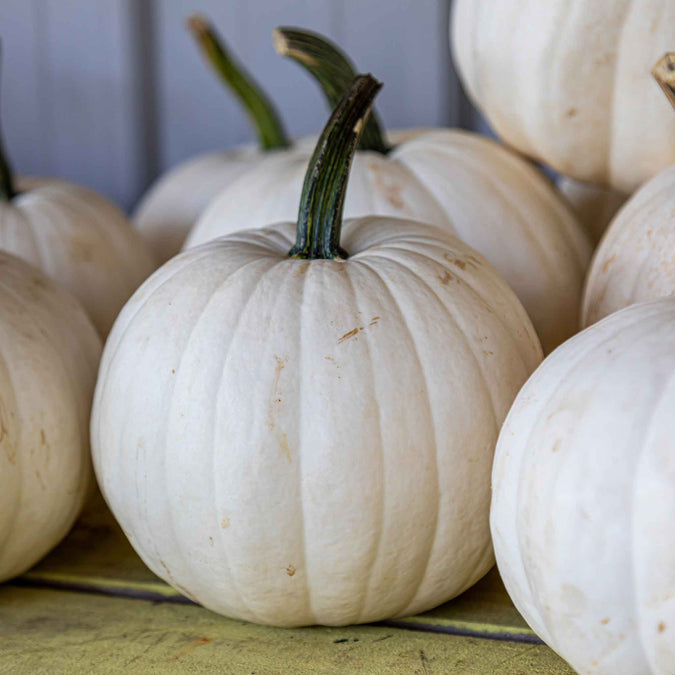
Dharaseeds
Pumpkin Seeds - Casper
Estimated delivery between April 15 and April 18.
The Casper pumpkin is a unique and striking variety, known for its pale, almost white skin and sweet, flavorful flesh. This medium-sized pumpkin has gained popularity for its distinctive color and is perfect for both decorative and culinary uses. Its smooth texture and mild flavor make it ideal for pies, soups, and other pumpkin-based dishes.
Key Benefits
- Unique Color: The Casper pumpkin’s smooth, white skin gives it a distinctive, ghostly appearance, making it perfect for autumn decor and Halloween displays.
- Culinary Versatility: While it's perfect for decorating, the flesh of the Casper pumpkin is sweet and creamy, making it an excellent choice for pies, soups, roasting, and baking.
- Medium-Sized Fruit: The average size of Casper pumpkins is about 8–10 pounds, which is perfect for both decoration and cooking without being too large.
- Disease Resistance: Casper pumpkins are known for being more resistant to common pumpkin diseases, making them easier to grow in a variety of climates.
Variety Features
- Plant Characteristics: The Casper pumpkin plant is a vigorous grower, producing healthy vines that can spread widely. Its strong vines allow it to produce high yields of beautiful pumpkins.
- Fruit Profile: The Casper pumpkin has a smooth, white skin and is typically medium in size (around 8–10 pounds). The flesh is bright orange, dense, and slightly sweet, perfect for culinary uses.
- Maturity: This variety takes about 95–105 days to reach full maturity from planting, making it an early to mid-season variety.
Planting Instructions
Planting Season
- Plant Casper pumpkin seeds after the danger of frost has passed and the soil temperature has reached about 70°F (21°C). Start seeds indoors 2–3 weeks before the last frost date for regions with shorter growing seasons.
Planting Details
- Seed Depth: Sow seeds 1 inch deep into fertile, well-draining soil.
- Spacing: Space seeds 36–48 inches apart, allowing enough room for the vines to spread.
- Soil Requirements: Pumpkins thrive in rich, well-draining soil with a slightly acidic to neutral pH (6.0–7.0). Add compost or organic matter to improve soil fertility and moisture retention.
Care Instructions
Watering
- Keep the soil evenly moist, especially during the flowering and fruit-setting stages. Water deeply at the base of the plant to avoid wetting the leaves, which can promote disease.
- Consistent watering is key for healthy pumpkin growth.
Fertilization
- Apply a balanced fertilizer at planting, followed by a fertilizer higher in phosphorus and potassium during the flowering and fruit-setting phases to support fruit development.
- Organic compost can be used throughout the growing season to improve soil health and provide nutrients.
Weeding and Mulching
- Mulch around the plants to retain moisture, suppress weeds, and regulate soil temperature.
- Regular weeding is important to avoid competition for nutrients.
Pest and Disease Control
- Watch for common pests like squash bugs, aphids, and cucumber beetles. Insecticidal soap or neem oil can help control pests.
- To avoid fungal diseases, ensure adequate spacing between plants for good air circulation and avoid overhead watering.
Harvesting
When to Harvest
- Casper pumpkins are ready for harvest when their skin has turned completely white and is firm to the touch. Check the stem—when it becomes hard and dry, the pumpkins are ready.
- Harvest typically occurs 95–105 days after planting, usually in mid to late fall.
How to Harvest
- Use a sharp knife or pruners to cut the pumpkin from the vine, leaving about 2 inches of stem attached to the fruit. Handle carefully to avoid bruising or damaging the skin.
Storage
- Storage Conditions: Store pumpkins in a cool, dry, and well-ventilated area to extend their shelf life. Casper pumpkins can last for 1–3 months if properly cured and stored.
- Curing: After harvesting, cure the pumpkins in a warm, dry area for 10–14 days to allow the skin to harden and improve their shelf life.
Culinary Uses
- Pumpkin Pie: Casper pumpkins make delicious, sweet pumpkin pies due to their tender flesh.
- Soups and Stews: The flesh is perfect for creamy pumpkin soups or stews.
- Roasting: Cut into chunks and roast for a savory side dish or salad ingredient.
- Baked Goods: Puree the flesh for muffins, breads, and other baked treats.
Conclusion
The Casper pumpkin is a stunning, versatile variety with unique white skin and a sweet, flavorful orange flesh. Ideal for both decorating and cooking, it brings a modern twist to traditional autumn pumpkins. With its easy care, good yield, and culinary potential, the Casper pumpkin is a great addition to any garden, offering both beauty and flavor.









